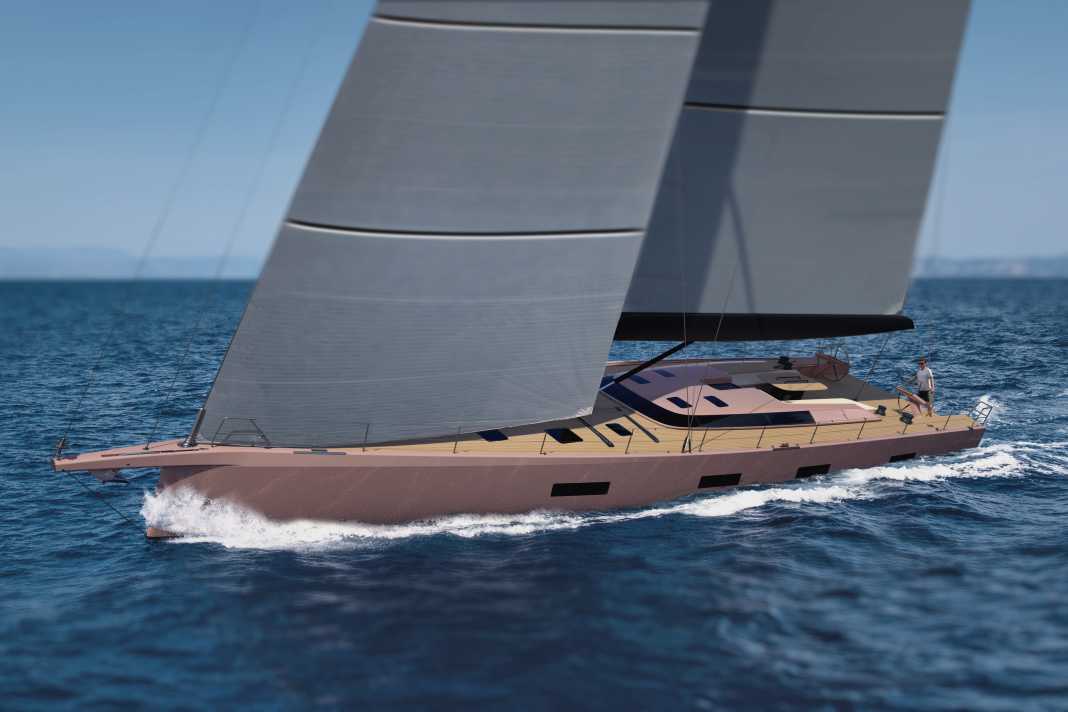





The 23.99 metre Baltic 80 Custom was commissioned by an experienced sailor who placed his first order with Baltic Yachts. The Finnish shipyard formulated the construction brief as follows: a fast offshore cruiser with the performance potential to win Mediterranean regattas. Judel/Vrolijk & Co translated these specifications into lines and lightweight structures. The carbon hull has a maximum width of 6.27 metres at the stern and is, in turn, heavily constricted at the waterline. The Bremerhaven design office drew a discreetly negative stem and hull sides that taper towards the deck and merge into a long bowsprit.
A racer in cruising dress
"Originally, the focus was on performance; we developed the concept with the help of extensive CFD and rating studies," explains designer Rolf Vrolijk. "With the involvement of the customer, cruising and living considerations became more important. We decided to keep the wide hull lines for high stability in racing and cruising. The freeboard was designed to be as low as possible in order to fulfil the space requirements for the interior. The focus was on a sleek look and a better vertical centre of gravity."
Twin rudders and a lift keel serve as appendages, enabling draughts of 3.50 metres to 5.30 metres. A Williams Sportjet 395 is parked in the stern garage. In race mode, the J1 is driven via a transverse rail; for easy handling, the self-tacking jib is used in cruising mode. The mainsail furls out of the boom. A large hatch in the sheer foredeck provides access to a spacious sail load that is not restricted by a forward cabin, as is usually the case in this size segment.
Judel/Vrolijk & Co received support for the exterior design from German product designer Jens Paulus, who also designs customised objects for Hermès and worked for Mallorcan designer Javier Jaudenes. This has already resulted in "WinWin" (33 metres, 2014) and most recently the 68-foot small series model for Baltic Café Racer. The exchange with Paulus resulted in the flat superstructure with a circumferential window strip that appears to float on the deck. The rose-coloured paintwork, which accentuates the carbon rigging and other deep black details, is also likely to have resulted from the collaboration.
Aft ship for crew and owner
The design below deck is a joint effort by Jens Paulus and Axel Vervoordt. They opted for details made of visible carbon fibre and had the majority of the surfaces painted or covered in fabric, with only the doors and floors clad in wood. The designers took a new approach to the room layout: instead of a master suite in the foredeck, they placed the owner's cabin aft on the starboard side. There is even space opposite for the crew cabin for two people, which has similar dimensions to the larger of the two double guest cabins forward of the mast. Baltics project manager Lars Gripenberg highlights the advantages of the unusual layout: "It is very versatile and is well suited for sailing on the high seas. She will be remarkably fast under sail and look stunning on the water. You could see her sailing in northern Europe before heading south towards the Mediterranean."
The Baltic 80 Custom was built using carbon epoxy construction. The hull and the structural bulkheads are made of Sprint laminates with a foam core and prepreg carbon reinforcements. For the deck, the Finnish yacht builders used prepreg carbon with a Nomex core. The entire deck structure weighs just 6.5 tonnes. The pushpit, railing supports and pop-up cleats are made of titanium to reduce weight and maintenance costs. The anchoring system is clear and simple, with a recess in the bowsprit that keeps the iron secure and ready for immediate use while underway. There is also a retractable hydraulic mooring winch on the foredeck.
When there is no wind, propulsion is provided conventionally by a 172-kilowatt diesel engine. In addition to the main generator, the engine has a second alternator that is specially designed for charging the batteries. In typical use, the battery capacity should be sufficient to run the air conditioning system throughout the night without having to use the generator.
In the new Baltic halls At the now sole Baltic Sea site in Jakobstad, work is underway on the third Café Racer (68 feet) and a 65-foot single with classic lines.

